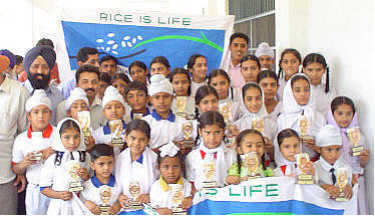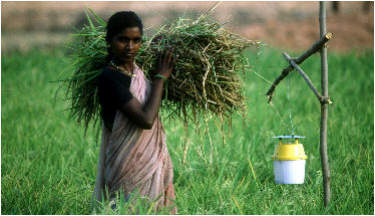Tiempo Climate Cyberlibrary
2004 - International Year of Rice
- Tiempo archive
- Complete issues
- Selected articles
- Cartoons
- Climate treaty
- Latest news
- Secretariat
- National reports
- IPCC
About the Cyberlibrary
The Tiempo Climate Cyberlibrary was developed by Mick Kelly and Sarah Granich on behalf of the Stockholm Environment Institute and the International Institute for Environment and Development, with sponsorship from the Swedish International Development Cooperation Agency.
While every effort is made to ensure that information on this site, and on other sites that are referenced here, is accurate, no liability for loss or damage resulting from use of this information can be accepted.
|
"Rice is Life" was taken as an appropriate theme when the United Nations General Assembly declared that 2004 would be the International Year of Rice. Newswatch editor Sarah Granich reports. |
Originating in Asia, rice is now cultivated in 113 countries and on all continents except Antarctica. It is grown on a wide range of soil regimes, from deltas and valleys in Asia, to tropical rainforests, to the slopes of the Himalayas, to the Mediterranean and to the dry lands of the Middle East.
For over half the world's population, rice is a staple food as well as being a vital source of employment for tens of millions of people. Rice production has, in fact, been described as the world's single most important economic activity. Rice-based systems are an intrinsic part of societies, cultures, politics, business and the environment throughout most parts of the world.
The importance of improving the productivity of rice systems throughout the world is paramount. For the 840 million undernourished people in developing countries who derive their meagre nutritional intake from this grain, it is a matter of life and death.
It was recognition of the global significance of rice, together with growing international concern over serious issues facing rice production, that led the International Rice Research Institute to request that the UN Food and Agriculture Organization collaborate in having 2004 declared International Year of Rice. To have a year dedicated to a single crop is unprecedented in the history of the United Nations General Assembly.
|
|
Students and teachers from Bankana Sahib Public School in Ludhiana, India, recently celebrated the International Year of Rice © FAO |
The overall aim of the International Year of Rice is to promote and guide the sustainable development of rice and rice-based production. The following challenges and opportunities have been identified by the organizers.
- Improving food security and nutrition. Although rice is a rich source of energy and protein, it has an incomplete amino acid profile and contains limited quantities of essential micronutrients. Nutrition can be improved by better rice processing and cooking techniques, the use of rice varieties with high nutritional values, and the fortification of rice with vitamins and minerals (for example, through applying food technology). Food security can be enhanced by promoting complementary crops, livestock and fisheries activities within rice-based systems. The International Year of Rice can help countries develop the infrastructure to support the responsible utilization of biotechnology. It can also increase awareness of the need to support the diversity of rice varieties to reduce genetic vulnerability and to enhance both rice productivity and quality. Diversity in rice-based systems greatly contributes to rural income and complete nutrition in a more balanced diet.
- Enhancing the productivity of rice-based systems. Sustainable rice development requires: i) genetic improvements for higher yield potential, for example, hybrid rice; ii) better crop management techniques; iii) reduced post-harvest operations; and iv) the development of integrated production systems. It also requires improved national capacity, through training and information exchange, and the national-level transfer of safety-tested new technologies to the field.
- Managing water resources. There is growing concern about the sustainability of global water resources. Water scarcity can be addressed by reducing the quantity of water required (through developing new rice varieties or improved irrigation systems) or by recycling water through multiple uses. The cultivation of rice in low-water regimes will lead to changes in water and nutrient management, cropping patterns and tillage practices. The International Year of Rice can help improve understanding of the costs and benefits of water use in rice-based systems (for example, the diverse life forms that such systems sustain). Technological developments and management interventions will also be required.
- Environmental protection. Environmental concerns in rice production include indiscriminate use of pesticides, inefficient use of fertilizers, and emissions of greenhouse gases. At the same time, rice-based ecosystems host a wealth of biodiversity, and the majority of the planting material used by poor farmers is derived from seeds that they produce themselves and that represent generations of local genetic resources. The International Year of Rice can spread awareness of the importance of preserving biogenetic and natural resources and can help stakeholders exchange ideas on environmental issues, challenges and opportunities.
|
|
© FAO |
- Traditional rice-based systems as part of world heritage. The International Year of Rice will raise awareness of the importance of benchmark rice-based systems, and will carry out activities to safeguard such systems and redress their erosion. The inclusion of outstanding rice-based systems in the multi-stakeholder, multi-agency Globally Important Agricultural Heritage Systems (GIAHS) Project represents a major opportunity. GIAHS is expected to lead to the creation of a new World Heritage for Agricultural Heritage Systems category under the World Heritage Convention.
- The institutional context. More and expanded partnerships between government and non-governmental (including private sector) development and agriculture institutions are required in order to increase farmers' - particularly women farmers' - access to land, credit, information and new technologies and innovations. This will be a central challenge in many countries.
- The challenge and opportunity for synergy. The overall challenge for rice-based systems is to identify and execute synergetic solutions for rice development, and these are possible only if decision-makers, technicians, farmers and civil society are well aware of the many factors related to sustainable rice production. In addition, sound policies on rice development depend on the harmonization of diverse policy instruments, which are often under the auspices of different ministries. The International Year of Rice aims to be an "information broker" for increasing information exchange, technology transfer and concrete action among all levels in the rice production chain and across all nations, for a synergetic approach to rice development and the improved management of rice-based systems.
The UN General Assembly noted that world attention needs to focus on the awareness that rice has a major role to play in alleviating and even possibly eradicating poverty and malnutrition. There are a number of internationally agreed development goals, including those contained in the Millennium Declaration, through which the entire global community can address the challenges of ensuring a sustainable increase in the production of rice.
Further information
The International Year of Rice framework consists of a
broad range of coordinated and organized activities and
initiatives across global, regional, national and local
levels. For comprehensive details on all events and
initiatives, see the official website at www.rice2004.org. A concept
paper documenting the thinking behind the International
Year of Rice is available. You can also download
papers from the February 2004 conference "Rice in
Global Markets and Sustainable Production
Systems".
On the Web
RiceWeb provides
access to a wealth of on-line information about rice,
including environmental issues.
Bright Ideas

General Electric plans to cut solar installation costs by half

Project 90 by 2030 supports South African school children and managers reduce their carbon footprint through its Club programme

Bath & North East Somerset Council in the United Kingdom has installed smart LED carriageway lighting that automatically adjusts to light and traffic levels

The United States National Oceanic and Atmospheric Administration and the American Public Gardens Association are mounting an educational exhibit at Longwood Gardens showing the link between temperature and planting zones

The energy-efficient Crowne Plaza Copenhagen Towers hotel is powered by renewable and sustainable sources, including integrated solar photovoltaics and guest-powered bicycles
El Hierro, one of the Canary Islands, plans to generate 80 per cent of its energy from renewable sources

The green roof on the Remarkables Primary School in New Zealand reduces stormwater runoff, provides insulation and doubles as an outdoor classroom

The Weather Info for All project aims to roll out up to five thousand automatic weather observation stations throughout Africa

SolSource turns its own waste heat into electricity or stores it in thermal fabrics, harnessing the sun's energy for cooking and electricity for low-income families

The Wave House uses vegetation for its architectural and environmental qualities, and especially in terms of thermal insulation

The Mbale compost-processing plant in Uganda produces cheaper fertilizer and reduces greenhouse gas emissions

At Casa Grande, Frito-Lay has reduced energy consumption by nearly a fifth since 2006 by, amongst other things, installing a heat recovery system to preheat cooking oil
Updated: May 15th 2015

